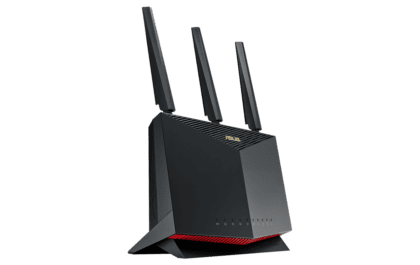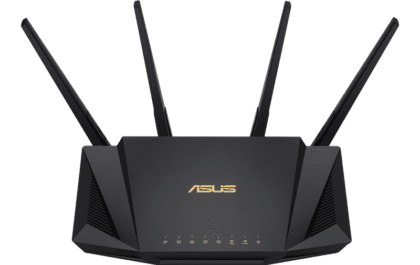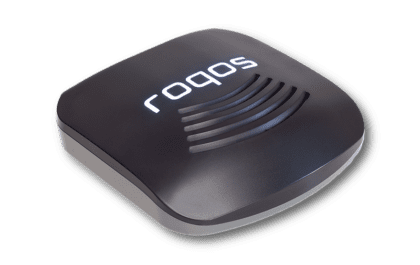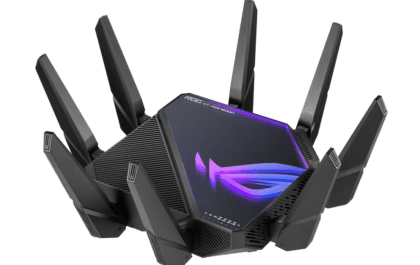The Difference Between Wireless-N, Wireless-AC, Wireless-AD, Wi-Fi 6, and Wi-Fi 6E

Are you one of those people constantly asking: Why is my Internet or Wi-Fi so slow? Most people generally refer to all Wireless Internet as Wi-Fi, but Wi-Fi is an oft misused term. Many are quick to blame their ISP for all of their internet problems. However, many times it all comes down to the type of router you are using and the speed it offers. Read on to see why you should ditch that old Wireless-N router and upgrade to a super-fast Wireless AC or a Wi-Fi 6 router!
In This Article
- Wireless Standards From Wireless-N to Wi-Fi 6
- What is Wireless-G?
- Do People Still Use Wireless-N?
- What is Wireless-AC?
- What is Wireless-AD?
- What is Wi-Fi 6 or Wireless-AX?
- Why You Should Upgrade To Wi-Fi 5 or Wi-Fi 6
- Great Routers Available Right Now!
- What About Wi-Fi 6E?
- Wireless Standards Broken Down
Best FlashRouters Available Now!
If you’re looking for a great router that features some of the newest Wi-Fi technology, grab one of our FlashRouters today!
Asus RT-AX86U PRO Merlin FlashRouter – Great for Large Homes / Perfect for 15+ Devices / Blazing-fast Wi-fi 6 (Wireless-AX) Speeds / Enhanced with Merlin Upgraded Firmware Maintains + Builds on MOST Premium Asus Router Standard Features
SALE PRICE: $304.99 $424.99 | BUY NOW GL.iNET Photo Frame Marble AX3000 VPN Router – Unique Photoframe Design to Customize / Dual Band Wireless AX3000 / Small form factor, perfect for all mounting / Hotel and other captive portal connections can also be configured.
PRICE: $159.99 | BUY NOW
Wireless Standards From Wireless-N to Wi-Fi 6
The wireless standard that we know today was created by the Institute of Electrical and Electronics Engineers or IEEE.
IEEE 802.11 is a wireless networking standard created to keep manufacturers of wireless routers and wireless networking devices (PlayStations, Laptops, Tablets, SmartTVs, Xboxes, iPhones, Roku) on the same page. These standards include IEEE 802.11a, 802.11b, 802.11g, 802.11n, 802.11ac, 802.11ad, and 802.11ax. So, what are these standards, and what do they have to do with you?
What Is Wireless-G? How Fast Is Wireless-G?
Wireless-G, also known as 802.11g, is an older wireless networking standard set by the IEEE. Mostly obsolete now, 802.11g offered speeds of up to 54 Mbps and was quickly adopted due to its upgrade in speed over 802.11b.
For example, you may notice that the speed in many coffee shops seem quite slow. This is because man run on slower Wireless-G (54 Mbps) routers, or even Wireless-B (11 Mbps). As a result, when so many people are constantly sharing the same connection, you get relatively low throughput speeds.
Do People Still Use Wireless-N?
Wireless-N, also known as Wi-Fi 4, was created to improve network throughput (maximum speed and transmission capabilities) over the two prior standards—802.11b and 802.11g.
Wireless-N was a significant upgrade from Wireless-G for the following reasons:
- Increased maximum data transmission rate from 54Mbps to up to 900Mbps
- Wider bandwidth capabilities to 40 Mhz
- Increased security and improvement of stability and range
While these features may have been an upgrade from Wireless-G, Wireless-N is mostly phased out. Luckily, new routers and wireless standards will still support Wireless-N and older wireless standards.
Looking for a router that supports your Wireless-N devices? Check out one of our most popular options!
Asus RT-AX86U PRO Merlin FlashRouter – Great for Large Homes / Perfect for 15+ Devices / Blazing-fast Wi-fi 6 (Wireless-AX) Speeds / Enhanced with Merlin Upgraded Firmware Maintains + Builds on MOST Premium Asus Router Standard Features SALE PRICE: $304.99 $424.99 | BUY NOW
What About Wi-Fi 5 / Wireless-AC?
Wi-Fi 5, also known as Wireless-AC, is one of the IEEE’s most popular wireless standards on the market today. The 802.11ac standard greatly improves nearly every aspect of Wireless-N.
Wireless-AC has increasingly become more formalized and is essentially the minimum for every wireless-capable device. Some improvements include:
- Increased maximum data transmission rates of up to 5300 Mbps
- Wider bandwidth capabilities of 80 Mhz as well as an optional 160 Mhz channel
- Additional 5 GHz frequency band for faster speeds and less wireless clutter
For the best Wi-Fi 5 speeds, check out one of our most popular routers below:
GL.iNET Photo Frame Marble AX3000 VPN Router – Unique Photoframe Design to Customize / Dual Band Wireless AX3000 / Small form factor, perfect for all mounting / Hotel and other captive portal connections can also be configured. PRICE: $159.99 | BUY NOW
What is Wireless-AD?
Wireless-AD is among the newer wireless standards to hit the consumer market. As with any new wireless standard, nearly every aspect has been improved and upgraded. Some of these upgrades include:
- Increased maximum data transmission rates of up to 7200 Mbps
- Additional 60 GHz frequency band
- High-quality 4K movie downloads in mere minutes
However, Wireless-AD is not backward compatible. Simply put, there are few very Wireless-AD compatible devices that support the new 60 GHz frequency band.
What is Wi-Fi 6 or Wireless-AX?

Unveiled at CES 2018, Wi-Fi 6, also known as Wireless-AX, is the next step in wireless standards. Wi-Fi 6 can deliver as much as five times the bandwidth as Wi-Fi 5. Current routers are equipped with 4×4 MU-MIMO (multi-user, multiple-input, and multiple-output), while wireless-AX Wi-Fi 6 routers will come standard with 8×8 MU-MIMO on both 2.4 GHz and 5 GHz bands. Essentially, Wireless-AX will support eight data streams up and down your network, doubling the previous standard.
Other upgrades from previous standards include: increased efficiency, reliability, and better coverage in large areas. While these specs sure do look enticing, Wi-Fi 6 routers are generally more expensive and are less customizable than Wi-Fi 5 routers. Additionally, these are mostly software upgrades and not a 6Ghz band as most anticipated.
Why You Should Upgrade To Wi-Fi 5 or Wi-Fi 6
Hanging onto an older Wireless-G or Wireless-N router means you are sacrificing overall speed and security while actually hindering the wireless capabilities for newer devices.
Using a Wireless-G or Wireless-N router with your iPad may feel like trying to catching a fish with a stick. It may work, but you’ll feel like you’re back on dialup! New wireless standards mean MAJOR wireless connectivity improvements. Best of all, newer routers are fully backwards compatible with older devices, so you’ll always be able to connect every device to the internet!
Great Routers Available Right Now!
At FlashRouters, we offer state-of-the-art routers that feature fully customizable firmware from the most popular firmware project like DD-WRT, Merlin, and more. While off-the-shelf routers often have features hidden, we unlock those secret benefits for you! Now, you’ll have more control over your Wi-Fi signal and improved signal strength, as well as full VPN integration at the tip of your fingers! Get one of our customer favorites today!
FEATURES
- Active Threat Monitoring
- Full Network & Bandwidth Control
- Built-in Ad-blocking
- Includes 1 Year of Roqos Core Protect Service
Get the Most Out of Wi-Fi 6!
FlashRouters has a number of Wi-Fi 6 solutions, that are perfect for future0proofing your network.
Asus RT-AX86U PRO Merlin FlashRouter

$424.99
- Great for Large Homes
- Perfect for 15+ Devices
GL.iNET Photo Frame Marble AX3000 VPN Router

- Unique Photoframe Design to Customize
- Dual Band Wireless AX3000
Asus RT-AX58U FlashRouter

$249.99
- Blazing-fast Wi-Fi 6 (Wireless-AX) Speeds
- Easy Router Setup via Asus App
For those that have an existing Wi-Fi 6 router from Asus and would like to supercharge it, FlashRouters offers a specialized solution.


FLASH MY ROUTER SERVICE INCLUDES:
- Supports Many Popular Asus Wi-Fi 6 Routers
- 3 VPN Profile Configurations
- Access to Asus App Management
- Asus Stock Firmware Capabilities
This personalized solution gives users with Wi-Fi 6 routers access to their favorite Asus features, VPN configuration, and a suite of customizations you won’t find anywhere else.
What About Wi-Fi 6E?
Wi-Fi 6E offers incredible upgrades for users. Many times, slow network speed is due to spectrum congestion, but this new specification will introduce a brand new band: 6GHz. It will also quadruple the amount of bandwidth available on your network.
With this, you’ll be able to use more devices effectively on your home network. Unfortunately, this doesn’t specifically mean too much of a speed boost that matters over 5GHz, as devices will need to be much closer to the router to reap the benefits. However, this will allow IoT devices close to the router to stay off the more widely used bands.
If you’re looking to future-proof your network for Wi-Fi AXE, take a look at some of our most popular FlashRouter models:
FEATURES
- Perfect for Max Wi-Fi (15+ Simultaneous Connections)
- Blazing-fast Wi-Fi 6E (Wireless-AXE)
- Performance Upgraded with Merlin Firmware
- Easy Asus App Router Setup
Wireless Standards Broken Down
Wireless G
Max Throughput (Speeds):
54 Mbps
Max Wireless Range (Radius):
75 Ft
Wireless Channel Widths:
20Mhz
Wireless Bands:
2.4 Ghz
Single Band
Wireless N
Max Throughput (Speeds):
900 Mbps
Max Wireless Range (Radius):
200 Ft
Wireless Channel Widths:
20/40 Mhz
Wireless Bands:
2.4 Ghz / 5Ghz
Dual Band
Wi-Fi 5 (Wireless AC)
Max Throughput (Speeds):
5300 Mbps
Max Wireless Range (Radius):
500 Ft
Wireless Channel Widths:
20/40/80/160 Mhz
Wireless Bands:
2.4 Ghz / 5 Ghz (x2)
Tri-Band
Wireless AD
Max Throughput (Speeds):
7200 Mbps
Max Wireless Range (Radius):
500 Ft
Wireless Channel Widths:
5/10/20 Mhz
Wireless Bands:
2.4 Ghz / 5 Ghz (x2) / 60 Ghz
Quad-Stream
Wi-Fi 6 (Wireless AX)
Max Throughput (Speeds):
10,000 Mbps
Max Wireless Range (Radius):
500+ Ft
Wireless Channel Widths:
20/40/80/160 Mhz
Wireless Bands:
2.4 Ghz / 5 Ghz (x2)
Tri-Band
Wi-Fi 6E (Wireless AXE)
Max Throughput (Speeds):
10,000 Mbps
Max Wireless Range (Radius):
500+ Ft
Wireless Channel Widths:
20/40/80/160 Mhz
Wireless Bands:
2.4 Ghz / 5 Ghz (x2) / 6 Ghz
Quad-Band
Wi-Fi 7 (Wireless BE)
Max Throughput (Speeds):
46,100 Mbps
Max Wireless Range (Radius):
500+ Ft
Wireless Channel Widths:
20/40/80/160/320 Mhz
Wireless Bands:
2.4 Ghz / 5 Ghz (x2) / 6 Ghz
Quad-Band
Of course, these ranges represent maximum distance in optimal conditions. Most of us don’t live in a world with no wireless interference. Even if you don’t see any other Wi-Fi Networks, devices such as cordless phones, baby monitors, and even microwaves can cause interference and limit your network range.
While Wireless-AD is the latest iteration of the standard, getting a premium Wi-Fi 5 router is the best way to ensure compatibility with the best performance.
Have any questions about Wireless-AC (Wi-Fi 5), Wireless-AD, Wireless-AX (Wi-Fi 6), Wi-Fi 6E, or router networking in general? Feel free to contact us!








